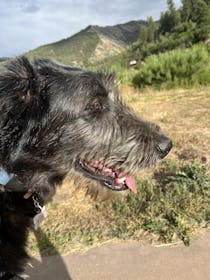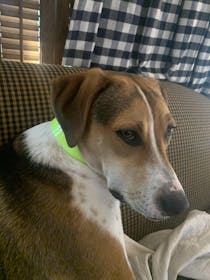Diagnosing and Treating Allergies and Atopic Dermatitis in Pets

Atopic dermatitis is the second most common form of skin conditions in pets (the first being flea allergies).
Basically, atopic dermatitis is a fancy word for allergies.
It has been estimated that 20-75% of small animals seen in the average veterinary practice have skin problems as the main complaint.
Atopic dermatitis generally develops in the late summer months and early fall, but depending on your climate, it can appear at any time of the year.
Causes of Canine Atopic Dermatitis
The causes of Canine Atopic Dermatitis vary greatly, but there is an inherited tendency to develop the antibodies (which are known as IgE) in certain breeds. This is especially true for Staffordshire terriers, Boxers, retrievers, Shar Pei's, Beagles, and even Irish Setters.
Mixed breeds are also known to contain the antibodies of atopic dermatitis, but they can be carried by any species.
Symptoms and Diagnosing
Atopy (the term that describes the symptoms of dermatitis) can manifest in many ways and generally begins between 1 to 3 years of age.
Generally symptoms show up as a “triad” of allergy symptoms, such as a rash and hay fever and asthma, or food allergies and eczema and conjunctivitis.
Other symptoms that may indicate Atopic Dermatitis include:
How It's Diagnosed
When diagnosing canine atopic dermatitis, veterinarians often look for a triad (three or more) of the following symptoms:
- Itchy skin (Pruritus)
- Sores around the lips, face or paws
- Thickening or hardening of the skin (lichenification) around the ankle (tarsal joint) or the extensor surface of the carpal joint
- Chronic or chronically relapsing dermatitis
- Individual or family history of atopy (a genetic predisposition of allergies)
- Breed predisposition of allergies
Other Symptoms
- Onset of symptoms before the age of three years
- Immediate skin test reactivity to inhalant allergens
- Elevated serum concentrations of allergen-specific IgGd
- Elevated serum concentrations of allergen-specific IgE
- Xerosis
- Recurrent superficial staphylococcal pyoderma
- Recurrent Malassezia pachydermatis infection
- Recurrent bilateral otitis externa
- Bilateral recurrent conjunctivitis
- Facial erythema and cheilitis (sore lips)
- Sweating
Treating Atopic Dermatitis with DERMagic
Step 1: Shampoo Your Pets
Bathe your dog with our Peppermint and Tea Tree Shampoo or our award-winning organic Skin Rescue Shampoo Bar. Peppermint and Tea Tree Oil Shampoo Bar or our Skin Rescue Shampoo Bar)
Note: Clip your dog’s hair if it is long. If the hair is very long, please cut it close to the skin (but do NOT shave).
Watch our short video for basic info and instructions about our products.
Step 2: Condition Fur
After rinsing shampoo from fur, apply our Peppermint and Tea Tree Conditioner, then rinse conditioner from fur and towel dry your pet.
Note: The liquid conditioner can be diluted. You should experiment with it to reach the consistency and strength that works best for you and your dog.
A less expensive and much more eco-friendly option is to use our organic Solid Conditioner Bar for Pets. Just one bar is equivalent to three bottles of liquid conditioner! Here is how to use our incredible conditioner bars:
Step 3: Skin Rescue Lotion
Massage DERMagic Skin Rescue Lotion deeply into the affected areas of the skin.
Apply lotion twice daily for 1-3 weeks, then once every day.
Use the product as you would use a lotion on yourself: not too much, not too little, and the skin should not appear greasy or wet. DERMagic Skin Rescue Lotion penetrates deeply into the follicles where mites, fungus and bacteria reside.
Keep a T-shirt on your dog to protect the skin and keep the lotion on your dog's skin. Try to keep him from licking the lotion, as it works much better if it stays on your dog's skin. If he does lick, don't worry - our products are completely safe and will not harm your dog.
Repeat these instructions each week. Bathe weekly for the first month, then twice monthly or as needed. Do not bathe too frequently! As your pet's skin and fur returns to health, it will begin to balance it's own pH levels.
Step 4: Cell Restoration Creme
As your pet's skin begins to heal, begin to apply our all-natural Cell Restoration Creme. This specialized creme helps facilitate growth and encourages healthy new cells to regenerate while keeping skin soft and conditioned.
Once you have completed treatment, continue with our shampoo and conditioner bars for each bath. This helps keep your pet's skin at optimal pH levels and will help prevent your pet from regressing.
How Long Does it Take to Work?
The DERMagic Skin Care System begins working quickly, but it will still take some time to see the results. Recovery depends on how advanced the condition became before treatment, your dog's diet, and the frequency of treatment.
You will see an immediate response after your first treatment as itchiness subsides and your pets begin to feel better. Most pets show immediate relief as their skin relaxes and becomes less itchy.
Full recovery usually averages 2-3 months. Your pet may recover much faster (as early as a few weeks) or it may take much longer before their fur completely grows back in (up to eight months).
Remember, it took time for your dog to develop this disease and it will take time to grow back. Be patient and consistent in treatment.




















